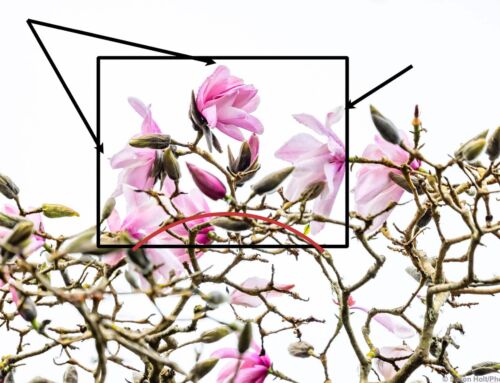Photographing trees is always a challenge. Trying to find a point of view to see the whole tree and separating it from its surroundings to see the true shape can be, well, often impossible.

Magnolia sprengeri v. ‘Diva’, in San Francisco Botanical Garden
Photographing flowering trees, big flowering trees, present even more problems since the flowers are so high, though when a big flowering tree is in its full glory, there is no worry about separating it from the background.
The deciduous magnolias at San Francisco Botanical Garden are at their peak in February, and as one of the gardens signature collections, they are a destination for garden photographers. Many of the trees are covered with flowers and hard to miss. To get the best photograph of the overall tree try to get as far back as possible and fill the frame with a zoom lens.
Other trees you could be right under and never know there is a flower show going off over your head. Then, when you try to photograph it looking up, the camera meter is fooled. This is when you need to understand the pluses and minuses of a camera exposure meter and how to control it to your advantage.

Magnolia sargentiana, (Sargent’s magnolia) in San Francisco Botanical Garden
The camera meter thinks everything it sees is “average” and combines the bright areas and the dark areas to come to a compromise. Looking up into the sky from the shade of a garden is a huge exposure problem for a camera and you need to tell it what you want to be correct.

Magnolia sargentiana, (Sargent’s magnolia) in San Francisco Botanical Garden
I would have walked past this Sargent’s Magnolia if I had not been looking for it on the garden map. To get a proper exposure I had to (technically) overexpose, brighten the image so that the flowers were not dull dark gray blotches.
With a longer lens I was able to compose a flower and branch pattern that really shows off the flowers, but I still had the same problem of the camera not knowing the exposure I want. I want the flowers to be exposed correctly.
Before and After Slider
As a full disclosure on the final image, I did some other post production work in the computer to bring out a bit of the blue sky. Exposing the flowers would normally really overexpose the sky. Recovering highlight detail in post production is a lesson for another day.
Sometimes though, you want the sky to go a rich blue behind the tree. In those instances you need to expose for the sky not the tree, underexposing what the camera thinks is the “average” exposure.
In this next example, a single flower on this Magnolia sprengeri was in the sun, and I wanted it to stand out. So I needed to set the exposure for the highlights, unlike the previous example where I set the exposure for the shade.
Before and After Slider
Looking up into trees and the sky with the camera definitely presents some interesting possibilities with shapes and silhouettes, and almost always the photographer needs to understand the pluses and minuses of correct exposure.











Leave A Comment